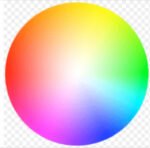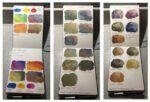When I talk about my choices of colours in paintings, I seem to refer quite…
Another Look At Colour Keys
This post has been planned for a while but it’s only now that I’ve got enough data around to be able to finally put it together.
A while back, I did a post on colour keys. If I do a painting that’s dominated by three primaries, there are eight different combinations of warm/cool blue, warm/cool yellow and warm/cool red that I could use. I’ve given these eight combinations names and, for all watercolours that have been based around three primaries, I’ve been stating in the posts which key I’ve painted in. What I’m doing today, though, is grouping together paintings by key in an attempt to identify common themes within individual keys and to just understand the keys a bit better. Basically, I’m a scientist at heart (more of a scientist than an artist) and I want to look at some experimental results and learn things.
First up is purple cool, made up of warm/purpley blue, cool/purpley red and cool/greeny yellow:
Interestingly, these paintings are not always purpley. If there’s purple anywhere, it tends to be in some cold looking skies. This key is capable of producing a wide range of colours (check out the two guys from the Hateful Eight in the middle). On the other hand, look at the two on the right in the middle row – when used with a bit of finesse, this key is great for painting chilly village mornings. And there are a couple in the top row that are a bit too dark and show how important it is to control values in this key.
Next, purple warm, made up of warm/purpley blue, cool/purpley red and warm/orangey yellow:
There are some outliers there but it’s clear that this is a fiery key, great for warm sunsets and for warm, inviting buildings. With the yellow and blue being as far from green as possible, it should come as no surprise that there’s not a lot of green in these paintings. And I don’t see a much of it here but there must be an opportunity within this key to set up some great orange/purple clashes.
Another warm palette, but this time, with warm versions of all three primaries, it’s much hotter. It’s a desert heat rather than a nice warm U.K. summer evening heat. The one in the top right is an exception but this is because I didn’t use much yellow in it. Again, the combination of warm blue and warm red mean that it’s hard to get any decent greens.
The temperature has come back down. These paintings feel cooler but they still have orange in them. So if I want orange colours but not the heat of the desert (e.g. for autumn landscapes), I need to include a cool blue in there. This key also seems to work well for churches if I want to make them warm and inviting. And green is back; some of these paintings have just as much green in them as orange.
Not much green in there, is there? To be honest, cool blues and cool yellows rarely make the best greens, I’d rather one of those two primaries was warm. Maybe it’s just that the cool yellow is raw sienna so often in these paintings rather than transparent yellow. Raw sienna is more earthy, so the sort of yellow I’d go for if the main subject of the painting was rocks or buildings. The best greens here are probably in the bottom left, showing that if I want to use the non-earthy transparent yellow within this key, I need to apply a delicate touch (something that may be lacking in the top right).
















Leave a Reply